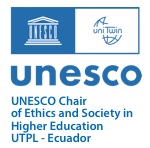Creative Coding: Computational Thinking And Constructivism From Intercultural Contexts
Abstract
This article will talk about two experiences of the use of programming languages in educational environments, for the promotion of intercultural contexts. The first one, called Wawakipu, is an educational program for children to 8 to 12 years old, based on Scratch, which seeks to “awaken computer thinking” through the development of video games, based on indigenous stories and myths. The second case is another educational program for a university audience called “Tejidos Autómatas”, which seeks to generate reflections on the complexity of social processes in relation to code present in indigenous weaves, expressed through p5 .js, a programming language for interactive art.
Downloads
References
Bergin, T. J. T. (2007). «A history of the history of programming languages». Communications of the ACM 50, no. 5: 69–74.
Cobo, C. (2016). La innovación pendiente. Reflexiones (y provocaciones) sobre educación, tecnología y conocimiento. Montevideo: Colección Fundación Ceibal.
Collins, A. (1998): «El potencial de las tecnologías de la información para la educación» en Vizcarro, C. y León. A. (Eds.): Nuevas tecnologías para el aprendizaje. Madrid. Piramide.
Jonassen, David H. (1994). «Thinking Technology: Toward a constructivist design model». Educational Technology 34, no. 4: 34–37.
McCloskey, E. M. (2012). «Docentes globales: un modelo conceptual para el desarrollo de la competencia intercultural on–line». Comunicar. doi: 10.3916/C38-2011-02-04
Papert, S., & Solomon, C. (1971). «Twenty things to do with a computer». MIT–A. I. Laboratory. Artificial Intelligence Memo 248. Recuperado de http://www.bitsavers.org/pdf/mit/ai/aim/AIM-248.pdf
Papert, S. (1981). Desafío a la mente. Computadoras y educación. Buenos Aires: Galápago.
Prieto, M. S. F. (2001). «La aplicación de las nuevas tecnologías en la educación». Tendencias pedagógicas 6: pp. 139–148.
Requena, S. H. (2008). «El modelo constructivista con las nuevas tecnologías: aplicado en el proceso de aprendizaje». RUSC. Universities and Knowledge Society Journal 5, no. 2: pp. 26–35.
Resnick, M., Maloney, J., Monroy – Hernández, A., Rusk, N., Eastmond, E., Brennan, K., ... Silverman, B. (2009).
«Scratch: Programming for all». Communications of the ACM 52, no. 11: pp. 60–67
Resnick, M. (2017). Lifelong Kindergarten: Cultivating Creativity Through Projects, Passion, Peers, and Play. MIT Press.
Sammet, J. E. (1972). «Programming languages: history and future». Communications of the ACM 15, no. 7: pp. 601–610.
Wexelblat, R. L. (Ed.). (2014). «History of programming languages». Academic Press.
Wing, J. M. (2006). «Computational thinking». Communications of the ACM 49, no. 3: pp. 33–35.
Wing, J. M. (2008). «Computational thinking and thinking about computing». Philosophical transactions of the royal society of London A: mathematical, physical and engineering sciences 366, no. 1881: pp. 3717–3725.
Zapata–Ros, M. (2015). «Pensamiento computacional: Una nueva alfabetización digital». RED. Revista de educación a distancia 46: pp. 1–47.
Copyright (c) 2019 © Analysis

This work is licensed under a Creative Commons Attribution-NonCommercial-NoDerivatives 4.0 International License.








